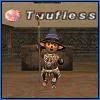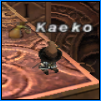 The Thin Black Line is here to protect you! Tuufless, our resident cute Taru (every site needs one!) is here to tell you all there is about magic and mages of all colors, especially Black. So much potency in such as small body, delivered to you every Friday! Today, Tuufless tries to get as far away from his subject as possible.
The Thin Black Line is here to protect you! Tuufless, our resident cute Taru (every site needs one!) is here to tell you all there is about magic and mages of all colors, especially Black. So much potency in such as small body, delivered to you every Friday! Today, Tuufless tries to get as far away from his subject as possible.
Previously, I briefly touched upon mana as one of the defining characteristics of a mage and talked about being wise with your mana consumption. The next basic trait of a traditional mage that I would like to bring up is that the vast majority of mage contributions to a fight come from a range (again, with exceptions like BLU).
Like last week, everything here will be very basic, since these are still fundamental concepts that we are dealing with.
For the uninformed, a player-controlled mage's casting range lies somewhere around 21.5" although this varies depending on the size of your target mob.
Flexibility
To start, I'll be the first to admit that I'm not going to win any prize or anything for saying that a mage’s casting range is much greater than melee range.
However, this gives mages a sense of flexibility. When fighting a mob, a melee job has to run up close to attack and a tank generally has the mob plastered against him or her. A mage on the other hand, can stand anywhere within 21.5" from the mob and still be able to contribute. Another way of looking at this is that your frontline is free to take the battle anywhere they want, as long as they stay within that 21.5” circle from the mages.
Because the area a mage can affect is much greater, mages don’t have to compensate as much for changes in a mob’s location. If a mob shifts from its location midfight, the entire frontline has to adjust to compensate for this, but the backline can usually just stay put, with maybe a couple of minor adjustments.
A mage's flexibility due to range is not just based on position- a mage is able to affect any targets within his or her casting range, and as such, all that is needed is effective targetting. One reason why one White Mage can provide effective healing for an entire party is because all the party members are easily accessible from the White Mage's location. Imagine if your White Mage had to physically run up to each party member that needed healing before being able to Cure the player, and how much harder things would be.
Safety
Ranged actions also largely negate the “squishiness” of mages, since one of a mage’s best forms of defense is simply not to get hit in the first place.
However, in the event that a mage does move to the top of an enemy’s hate list, range means that there will be a little bit of time available for appropriate measures to be taken. This little bit of time is significant- if you’ve seen a Black Mage solo Operation Desert Swarm, the very fact that mobs takes time to cover the distance in between you and the mob is critical in letting you to fire off that Sleepga.
While it is true that several mobs have abilities that affect a much larger radius than just melee, there will oftentimes still be that narrow band where mages can still contribute to the fight while staying safe. An example of this would be The Wyrmking Descends, where many of Bahamut’s crippling moves only affect players within 20.0”. Thus, standing anything between 20.1” and 21.5” from Bahamut allows mages to still contribute to the fight, while avoiding Bahamut’s moves.
Some other fights involve mob attacks that extend beyond casting range, like Khimaira’s Fulmination (30”). Fortunately, mages still have other options available to them, such as using the terrain to their advantage.
Terrain
Mages are in greater position to take advantage of any terrain features that may dot the surrounding area because of range.
Range allows mages to take advantage of terrain to further protect themselves by putting favourable terrain obstacles in between the mage and the mob. Sometimes, as in the above Khimaira example, differences in terrain height can be used to keep the mage safe from Fulmination. The key point here is that the mage is still in a position to contribute towards the fight.
Actual terrain obstacles also serve to increase the effective distance between the mages and the mob because even though the mob may be within casting range, it is forced to sidetrack in order to get to you. Good examples of this are the ramps that surround the Ix’DRG Aerns or the cliffs just before the dragons in Dynamis-Xarcabard.
Both these examples use a difference in height from keeping the backline safe, but in the event that a mage takes hate, the mob will have to cover much more distance to reach the mages, even though the mob stays within casting range throughout.
Fin.
With that, I'll wrap up this aspect of understanding how mages play. There is one final small thing that I would like to cover before moving onto more practical parts of playing a mage, as opposed to sticking with basic theory, so please stay tuned for that!
Monday, June 22, 2009
The Thin Black Line: From afar.
Posted by
Tuufless
at
6:09 PM
Labels:
Black Mage,
The Thin Black Line,
Tuufless
Subscribe to:
Post Comments (Atom)





 #1 ~ Monk
#1 ~ Monk #2 ~ Samurai
#2 ~ Samurai #3 ~ Ninja
#3 ~ Ninja #4 ~ Dragoon
#4 ~ Dragoon Chaotic Pellucidity
Chaotic Pellucidity Teabags and KY Jelly
Teabags and KY Jelly The Bloggaru!
The Bloggaru!

1 comment:
Also, when things do go bad and you find yourselves under direct attack, mage jobs in general have access to a generous amount of damage reduction gear (earth staff, cheviot cape, sorcerer's earring, etc...). Having that gear available, usually as part of an idle gear set will save your life a lot!
Post a Comment